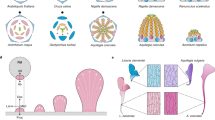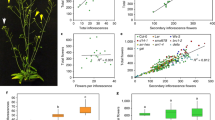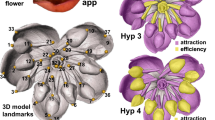Abstract
Spiral flowers usually bear a variable number of organs, suggestive of the flexibility in structure. The mechanisms underlying the flexibility, however, remain unclear. Here we show that in Nigella damascena, a species with spiral flowers, different types of floral organs show different ranges of variation in number. We also show that the total number of organs per flower is largely dependent on the initial size of the floral meristem, whereas the respective numbers of different types of floral organs are determined by the functional domains of corresponding genetic programmes. By conducting extensive expression and functional studies, we further elucidate the genetic programmes that specify the identities of different types of floral organs. Notably, the AGL6-lineage member NdAGL6, rather than the AP1-lineage members NdFL1/2, is an A-function gene, whereas petaloidy of sepals is not controlled by AP3- or PI-lineage members. Moreover, owing to the formation of a regulatory network, some floral organ identity genes also regulate the boundaries between different types of floral organs. On the basis of these results, we propose that the floral organ identity determination programme is highly dynamic and shows considerable flexibility. Transitions from spiral to whorled flowers, therefore, may be explained by evolution of the mechanisms that reduce the flexibility.
This is a preview of subscription content, access via your institution
Access options
Subscribe to this journal
Receive 12 digital issues and online access to articles
$119.00 per year
only $9.92 per issue
Buy this article
- Purchase on Springer Link
- Instant access to full article PDF
Prices may be subject to local taxes which are calculated during checkout




Similar content being viewed by others
References
Bowman, J. L., Smyth, D. R. & Meyerowitz, E. M. Genes directing flower development in Arabidopsis. Plant Cell 1, 37–52 (1989).
Schwarz-Sommer, Z., Huijser, P., Nacken, W., Saedler, H. & Sommer, H. Genetic control of flower development by homeotic genes in Antirrhinum majus. Science 250, 931–936 (1990).
Coen, E. S. & Meyerowitz, E. M. The war of the whorls: genetic interactions controlling flower development. Nature 353, 31–37 (1991).
Pelaz, S., Ditta, G. S., Baumann, E., Wisman, E. & Yanofsky, M. F. B and C floral organ identity functions require SEPALLATA MADS-box genes. Nature 405, 200–203 (2000).
Honma, T. & Goto, K. Complexes of MADS-box proteins are sufficient to convert leaves into floral organs. Nature 409, 525–529 (2001).
Theissen, G. Development of floral organ identity: stories from the MADS house. Curr. Opin. Plant Biol. 4, 75–85 (2001).
Ferrario, S., Immink, R. G. & Angenent, G. C. Conservation and diversity in flower land. Curr. Opin. Plant Biol. 7, 84–91 (2004).
Litt, A. & Kramer, E. M. The ABC model and the diversification of floral organ identity. Semin. Cell Dev. Biol. 21, 129–137 (2010).
Causier, B., Schwarz-Sommer, Z. & Davies, B. Floral organ identity: 20 years of ABCs. Semin. Cell Dev. Biol. 21, 73–79 (2010).
Mandel, M. A., Gustafson-Brown, C., Savidge, B. & Yanofsky, M. F. Molecular characterization of the Arabidopsis floral homeotic gene APETALA1. Nature 360, 273–277 (1992).
Kim, S. et al. Expression of floral MADS-box genes in basal angiosperms: implications for the evolution of floral regulators. Plant J. 43, 724–744 (2005).
Soltis, D. E., Chanderbali, A. S., Kim, S., Buzgo, M. & Soltis, P. S. The ABC model and its applicability to basal angiosperms. Ann. Bot. 100, 155–163 (2007).
Endress, P. K. & Doyle, J. A. Floral phyllotaxis in basal angiosperms: development and evolution. Curr. Opin. Plant Biol. 10, 52–57 (2007).
Endress, P. K. The early evolution of the angiosperm flower. Trends Ecol. Evol. 2, 300–304 (1987).
Soltis, P. S. et al. Floral variation and floral genetics in basal angiosperms. Am. J. Bot. 96, 110–128 (2009).
Ronse De Craene, L. P., Soltis, P. S. & Soltis, D. E. Evolution of floral structures in basal angiosperms. Int. J. Plant Sci. 164, S329–S363 (2003).
Zhang, R. et al. Disruption of the petal identity gene APETALA3-3 is highly correlated with loss of petals within the buttercup family (Ranunculaceae). Proc. Natl Acad. Sci. USA 110, 5074–5079 (2013).
Goncalves, B. et al. An APETALA3 homolog controls both petal identity and floral meristem patterning in Nigella damascena L. (Ranunculaceae). Plant J. 76, 223–235 (2013).
Running, M. P. & Hake, S. The role of floral meristems in patterning. Curr. Opin. Plant Biol. 4, 69–74 (2001).
Hill, J. P. & Lord, E. M. Floral development in Arabidopsis thaliana – a comparison of the wild-type and the homeotic pistillata mutant. Can. J. Bot. 67, 2922–2936 (1989).
Jack, T., Brockman, L. L. & Meyerowitz, E. M. The homeotic gene APETALA3 of Arabidopsis thaliana encodes a MADS box and is expressed in petals and stamens. Cell 68, 683–697 (1992).
Riechmann, J. L., Krizek, B. A. & Meyerowitz, E. M. Dimerization specificity of Arabidopsis MADS domain homeotic proteins APETALA1, APETALA3, PISTILLATA, and AGAMOUS. Proc. Natl Acad. Sci. USA 93, 4793–4798 (1996).
Kramer, E. M. et al. Elaboration of B gene function to include the identity of novel floral organs in the lower eudicot Aquilegia. Plant Cell 19, 750–766 (2007).
Kramer, E. M. New model systems for the study of developmental evolution in plants. Curr. Top. Dev. Biol. 86, 67–105 (2009).
Chanderbali, A. S. et al. Genetic footprints of stamen ancestors guide perianth evolution in Persea (Lauraceae). Int. J. Plant Sci. 167, 1075–1089 (2006).
Baum, D. A. The evolution of plant development. Curr. Opin. Plant Biol. 1, 79–86 (1998).
Douglas, A. W. The developmental basis of morphological diversification and synorganization in flowers of Conospermeae (Stirlingia and Conosperminae: Proteaceae). Int. J. Plant Sci. 158, S13–S48 (1997).
Smith, R. S., Kuhlemeier, C. & Prusinkiewicz, P. Inhibition fields for phyllotactic pattern formation: a simulation study. Can. J. Bot. 84, 1635–1649 (2006).
Jabbour, F., De Craene, L. P. R., Nadot, S. & Damerval, C. Establishment of zygomorphy on an ontogenic spiral and evolution of perianth in the tribe Delphinieae (Ranunculaceae). Ann. Bot. 104, 809–822 (2009).
Corley, S. B., Carpenter, R., Copsey, L. & Coen, E. Floral asymmetry involves an interplay between TCP and MYB transcription factors in Antirrhinum. Proc. Natl Acad. Sci. USA 102, 5068–5073 (2005).
LaRue, N. C., Sullivan, A. M. & Di Stilio, V. S. Functional recapitulation of transitions in sexual systems by homeosis during the evolution of dioecy in Thalictrum. Front. Plant Sci. 4, 487 (2013).
Zachgo, S. et al. Functional analysis of the Antirrhinum floral homeotic DEFICIENS gene in vivo and in vitro by using a temperature-sensitive mutant. Development 121, 2861–2875 (1995).
Ito, T., Ng, K. H., Lim, T. S., Yu, H. & Meyerowitz, E. M. The homeotic protein AGAMOUS controls late stamen development by regulating a jasmonate biosynthetic gene in Arabidopsis. Plant Cell 19, 3516–3529 (2007).
Wuest, S. E. et al. Molecular basis for the specification of floral organs by APETALA3 and PISTILLATA. Proc. Natl Acad. Sci. USA 109, 13452–13457 (2012).
Zahn, L. M. et al. Conservation and divergence in the AGAMOUS subfamily of MADS-box genes: evidence of independent sub- and neofunctionalization events. Evol. Dev. 8, 30–45 (2006).
Yellina, A. L. et al. Floral homeotic C function genes repress specific B function genes in the carpel whorl of the basal eudicot California poppy (Eschscholzia californica). Evodevo 1, 13 (2010).
Di Stilio, V. S., Kramer, E. M. & Baum, D. A. Floral MADS box genes and homeotic gender dimorphism in Thalictrum dioicum (Ranunculaceae) – a new model for the study of dioecy. Plant J. 41, 755–766 (2005).
Galimba, K. D. & Di Stilio, V. S. Sub-functionalization to ovule development following duplication of a floral organ identity gene. Dev. Biol. 405, 158–172 (2015).
Wardlaw, C. W. The floral meristem as a reaction system. Proc. R. Soc. Edinb. B. 66, 394–408 (1957).
Hicks, G. S. & Sussex, I. M. Organ regeneration in sterile culture after median bisection of the flower primordia of Nicotiana tabacum. Bot. Gaz. 132, 350–363 (1971).
Coen, E. S. The role of homeotic genes in flower development and evolution. Annu. Rev. Plant Physiol. Mol. Biol. 42, 241–279 (1991).
Day, C. D., Galgoci, B. F. C. & Irish, V. F. Genetic ablation of petal and stamen primordia to elucidate cell-interactions during floral development. Development 121, 2887–2895 (1995).
Chanderbali, A. S. et al. Conservation and canalization of gene expression during angiosperm diversification accompany the origin and evolution of the flower. Proc. Natl Acad. Sci. USA 107, 22570–22575 (2010).
Guindon, S. et al. New algorithms and methods to estimate maximum-likelihood phylogenies: assessing the performance of PhyML 3.0. Syst. Biol. 59, 307–321 (2010).
Livak, K. J. & Schmittgen, T. D. Analysis of relative gene expression data using real-time quantitative PCR and the 2−ΔΔCT method. Methods 25, 402–408 (2001).
Kramer, E. M. Methods for studying the evolution of plant reproductive structures: comparative gene expression techniques. Methods Enzymol. 395, 617–636 (2005).
Grabherr, M. G. et al. Full-length transcriptome assembly from RNA-Seq data without a reference genome. Nature Biotechnol. 29, 644–652 (2011).
Mortazavi, A., Williams, B. A., McCue, K., Schaeffer, L. & Wold, B. Mapping and quantifying mammalian transcriptomes by RNA-Seq. Nature Methods 5, 621–628 (2008).
Gould, B. & Kramer, E. M. Virus-induced gene silencing as a tool for functional analyses in the emerging model plant Aquilegia (columbine, Ranunculaceae). Plant Methods 3, 6 (2007).
Acknowledgements
We thank members of the Kong laboratory for helpful discussion, and E. M. Kramer, S.-H. Shiu and three anonymous reviewers for valuable comments. This work was supported by National Natural Science Foundation of China Grants 31125005 and 31330007 and CAS Interdisciplinary Innovation Team.
Author information
Authors and Affiliations
Contributions
P.W. and H.K. designed the research. P.W., H.L. and W.Z. performed the qRT–PCR, in situ hybridization and VIGS experiments, with the help of R.Z. and H.S. for analyzing the data. R.Z. and X. Yu provided the RNA-seq and yeast two-hybrid results, respectively, and P.W., X.D. and X. Yao conducted the morphological analyses. P.W., H.S. and H.K. wrote the manuscript.
Corresponding author
Ethics declarations
Competing interests
The authors declare no competing financial interests.
Supplementary information
Rights and permissions
About this article
Cite this article
Wang, P., Liao, H., Zhang, W. et al. Flexibility in the structure of spiral flowers and its underlying mechanisms. Nature Plants 2, 15188 (2016). https://doi.org/10.1038/nplants.2015.188
Received:
Accepted:
Published:
DOI: https://doi.org/10.1038/nplants.2015.188
This article is cited by
-
Seasonal variation of two floral patterns in Clematis ‘Vyvyan Pennell’ and its underlying mechanism
BMC Plant Biology (2024)
-
Candidate genes screening based on phenotypic observation and transcriptome analysis for double flower of Prunus mume
BMC Plant Biology (2022)
-
The pineapple MADS-box gene family and the evolution of early monocot flower
Scientific Reports (2021)
-
Developmental stochasticity and variation in floral phyllotaxis
Journal of Plant Research (2021)
-
Can the anatomy of abnormal flowers elucidate relationships of the androecial members in the ginger (Zingiberaceae)?
EvoDevo (2020)



